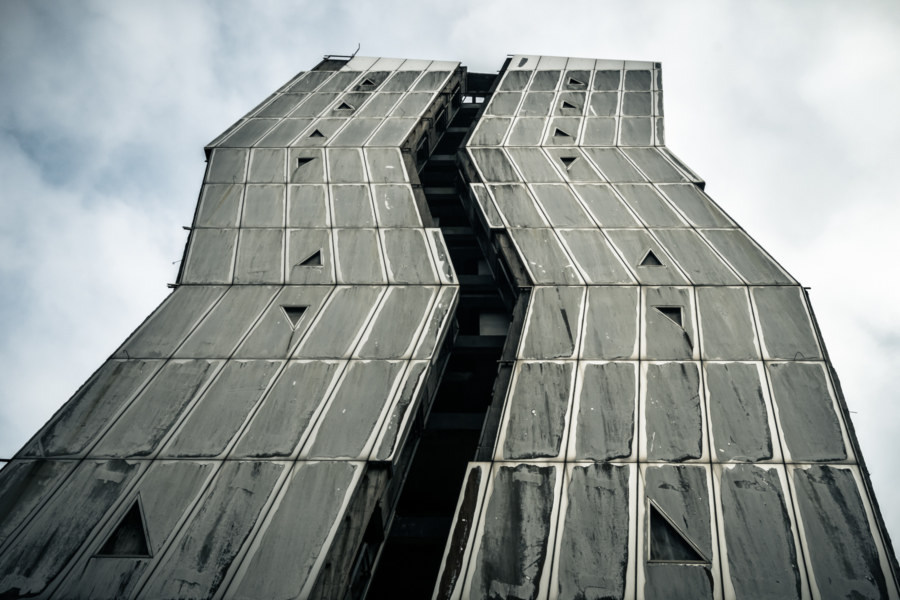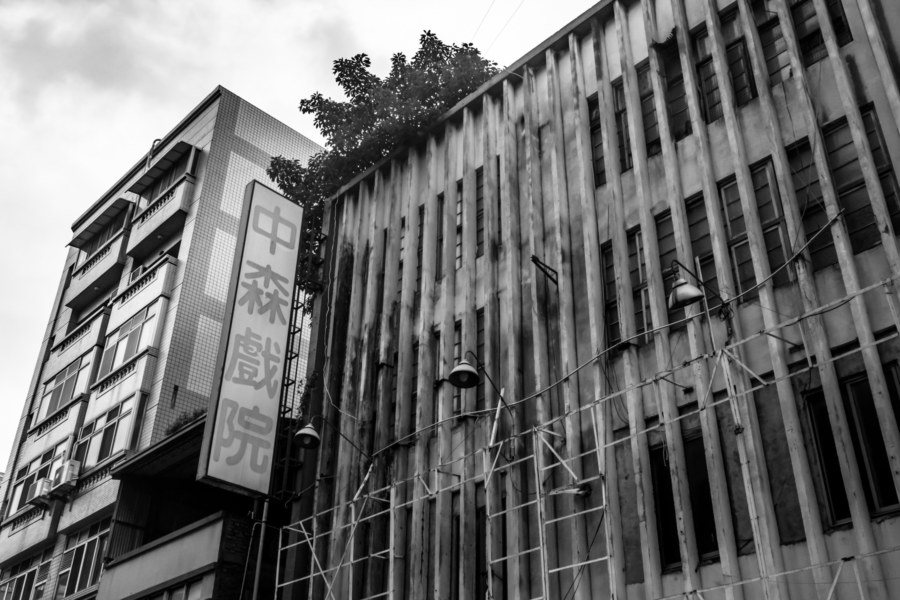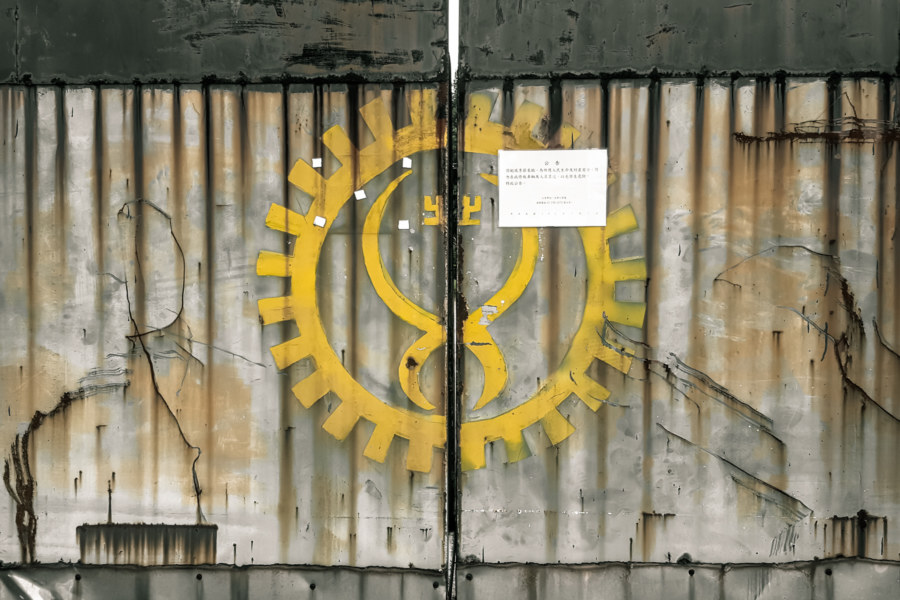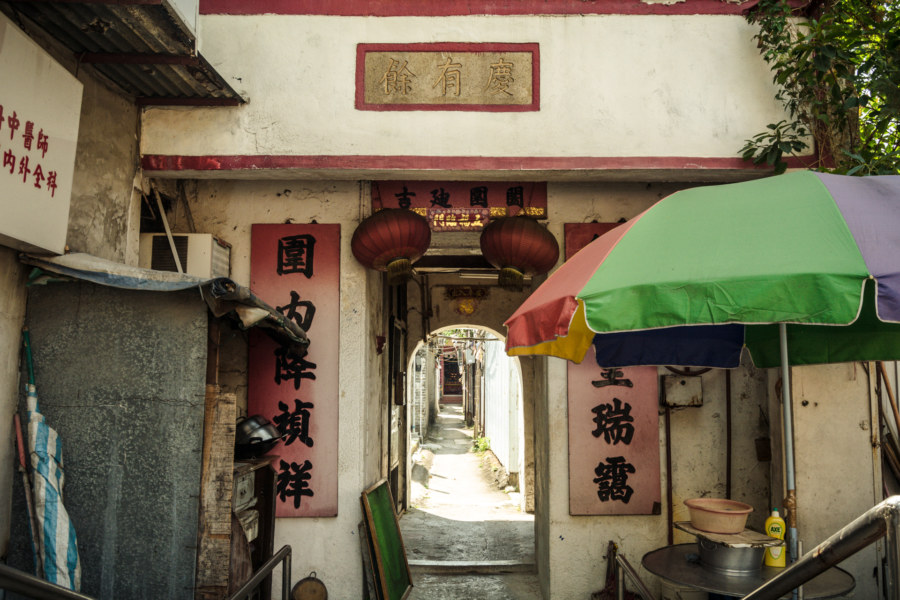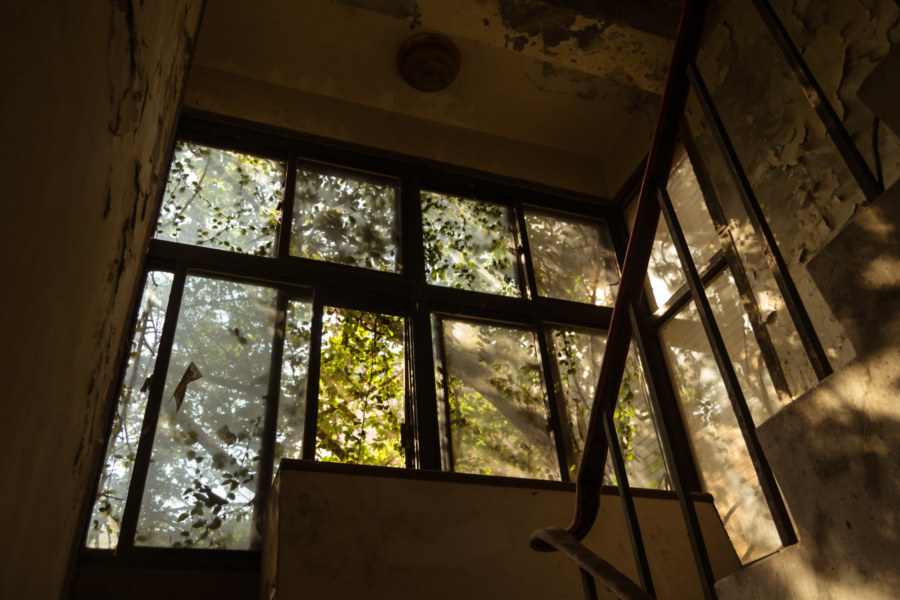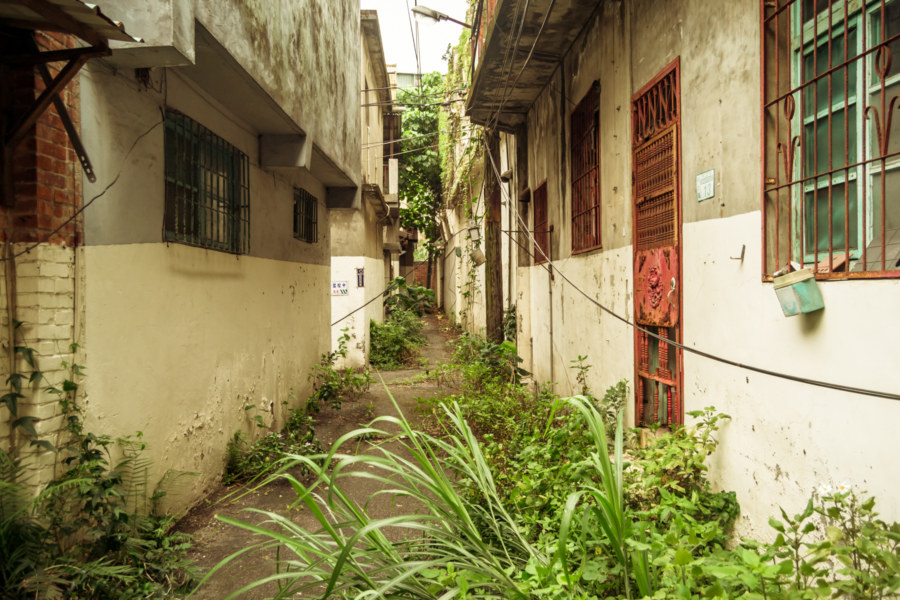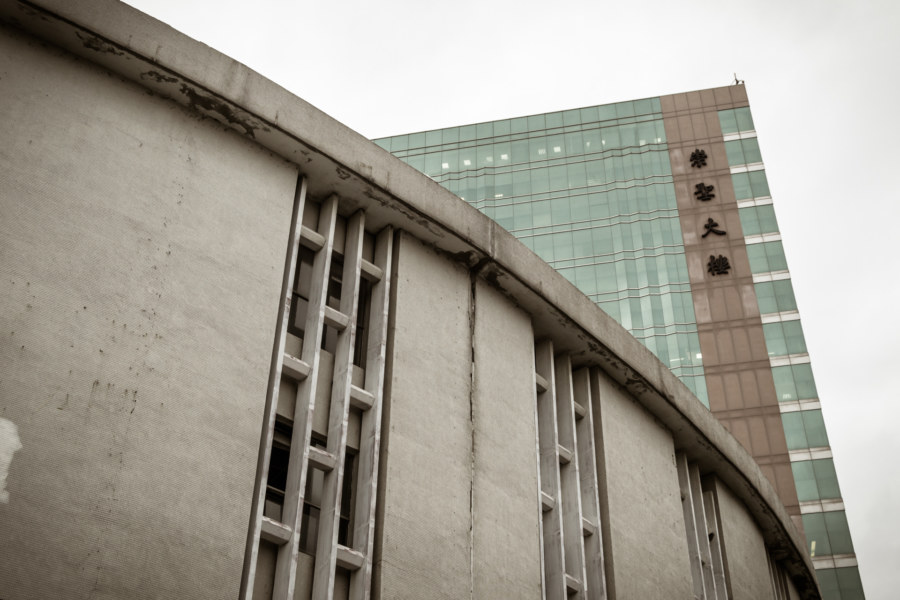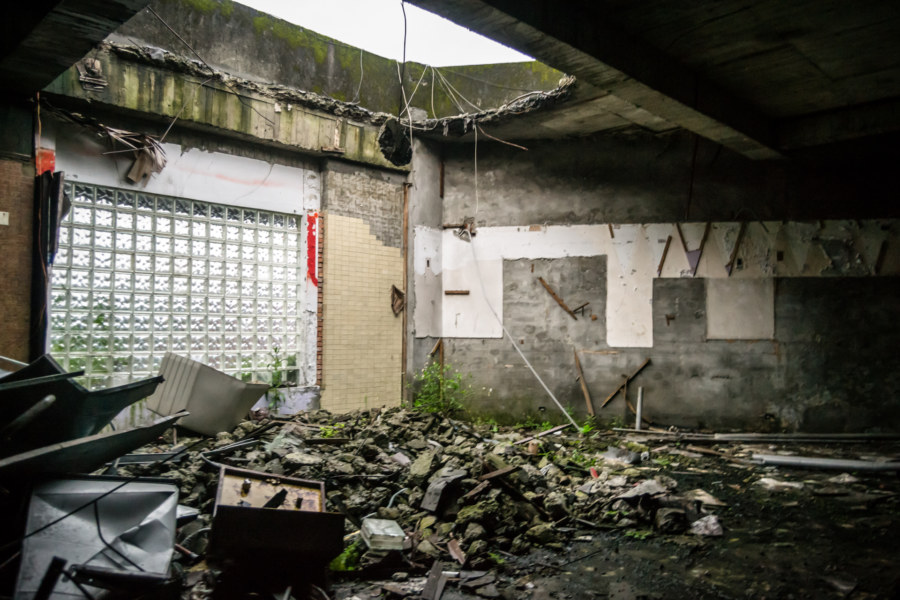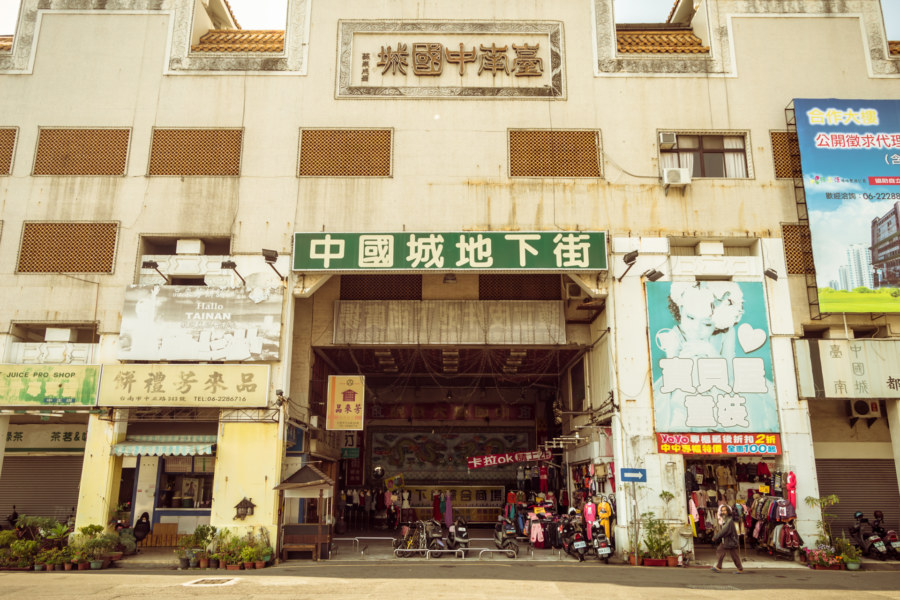Linkou Lightning Building (林口閃電大樓) is an infamous ruin not far from the newly-opened Taoyuan Airport MRT line in Linkou, recently named the fastest-growing district in New Taipei. Media reports often describe it as the Linkou Monster House (林口怪怪屋) and it regularly appears alongside the Longtan Monster House and other examples of the genre. While I wish there were a good story to go along with these photos it sounds as if it is simply a failed construction project where nobody wanted to cover the cost of demolition until recently.
Vanished places receding from human memory. Often there is nothing more than photographs to recall what was once there. See also: abandoned and urbex.
Adjacent Terms
Zhongsen Theater 中森戲院
Taichung is changing fast. The historic downtown area, formerly one of the worst examples of inner city blight in the nation, is presently undergoing a massive urban renewal effort. Some decaying and disused commercial buildings have been restored, many more await their fate, and others have been demolished before I’ve even had a chance to document their interiors. Zhōngsēn Theater 中森戲院 belongs to this last category: it came down after I shot a preliminary set of photos but before I had a chance to sneak inside. You have to move fast to capture these small histories in their unmaking.
Traces of an Army Maintenance Depot
Xinyi is now one of the most expensive and upscale parts of Taiwan but it hasn’t always been that way. Decades ago it was an undesirable area on the edge of the city with a significant military-industrial presence, traces of which still remain if you know where to look. The open expanse of parks and parking lots around the intersection of Xìn’ān Street (信安街) and Wúxìng Street (吳興街) immediately to the west of Taipei Medical University (臺北醫學大學) is one such trace.
Nga Tsin Wai: The Last Walled Village of Kowloon
Nga Tsin Wai Village 衙前圍村 is widely known as the last walled village of Kowloon. Located not far from the former location of the infamous Kowloon Walled City 九龍城寨, the village traces its history back to the 1352 founding of its modest Tin Hau Temple 天后宮. It was fortified in 1724 to defend against bandits and pirates but has, in modern times, lost the moat, walls, and watchtowers that once protected residents from harm. As the very last of its kind in the urban heart of Hong Kong it has become a flashpoint for conflict between the Urban Renewal Authority and the many activist groups and citizens passionate about preserving what remains of Kowloon’s cultural heritage.
Keelung Road Guest House 基隆路招待所
Not far from Taipei 101 and the heart of Taipei’s central business district one will find an ulcerous anomaly on the supine body of the sprawling city. It would be impossible to miss this ruin, for a wild riot of plant life traces its angular outlines, and an unusual assortment of graffiti gilds the arcade along Keelung Road. I regularly ride by here on my way to various working cafes further afield and naturally couldn’t resist taking a look inside one day. I have not puzzled out the formal name of this abandonment but strongly suspect it was an official guest house related to the armed forces, particularly as it was located adjacent to the former #44 West Village (四四西村), a military dependents’ settlement.
Jiangling New Village 江陵新村
Jiānglíng New Village (江陵新村) was one of more than 800 military dependents’ village in Taiwan before its ultimate destruction in mid-2015. It was formerly located not far from the confluence of Jingmei River (景美溪) and Xindian River (新店溪) just outside Taipei city limits in the northern part of Xindian. Immediately to the south is an active military base of some kind—and the historic Jingmei Prison can be found on the opposite side of the nearest major intersection.
Second Taipei City Council Building 第二台北市議會大廈
One of the more peculiar ruins I’ve seen in Taiwan was a building immediately across from the Control Yuan (監察院), one of the five branches of government, on Zhōngxiào West Road (忠孝西路). It was inaugurated as the second home of the Taipei City Council (台北市議會) in 1964 after moving from nearby Zhongshan Hall (中山堂). In 1990 the city council relocated to its present base in Xinyi and the building was converted into a police station before being completely abandoned in 2007. Despite this the building continued to be known as the Second Taipei City Council Building (第二台北市議會大廈).
Tongyi Bowling Alley 統一保齡球館
Keelung, like many cities in Taiwan, is a dark wonderland for urban exploration. You can hardly turn around without sighting yet another hulking ruin calling out to be entered. Most of these buildings are so decrepit that little remains to indicate what its purpose once was—a direct consequence of Keelung’s incessant rain and gloom. The process of decay works at a feverish pace in this grim port city, rapidly eroding evidence of human occupation in any abandonment exposed to the elements.
Tainan Chinatown 臺南中國城
Tainan Chinatown 臺南中國城 is a half-abandoned and soon to be demolished shopping mall and entertainment complex in Tainan City. Built in 1983, it was designed by C.Y. Lee, a famous architect who later directed the construction of 85 Sky Tower and Taipei 101. I went by to shoot a few photos with some friends one sunny afternoon in January 2014 so I figure I may as well share them here.
